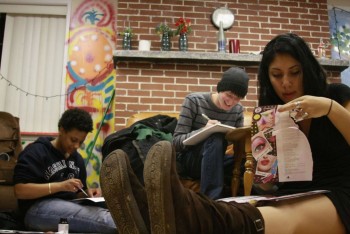Students Exercise Their "Right to Art" at James House

Haverford students can pursue their individual art projects at James House any time of day.
Details
There's a place on Haverford's campus where students can go to write, knit, fire some pottery, design their own coloring books, learn the fine art of woodchip carving, and explore art in all its diverse forms.
James House, the student art space of Haverford College, offers 24-hour, seven-day-a-week access to meeting spaces, studios, and equipment such as sewing machines, paintbrushes, and kilns. More and more, James House, which officially opened in March of 2007, is becoming a hub of student-centered artistic activity, hosting a variety of workshops, programs, and events. During the fall semester, these have included a writing workshop led by James House board members Justin Dainer-Best and Emma Eisenberg (both class of '09), a visit by poet John Rybicki also organized by Dainer-Best, an appearance by performance artist Pat Oleszko sponsored by fellow board member Jacob Carroll '09, and, coming in December, a woodchip carving workshop led by Sheba Brown '10.
On Tuesday, November 25, the house and its participants had a chance to shine in a local spotlight when Rob Stoller of Art in Motion, who is working with WHYY on a documentary series about art initiatives on Philadelphia-area college campuses, filmed at the space and talked with students about their art.
“We are always planning either student-run or local artist-run workshops for students to participate in,” says Carroll.“We also hold art parties such as our first event of the semester, which was a post-it note party—we provided post-it notes and markers and our guests had the opportunity to make whatever they wanted.” Future plans include workshops in coloring book and flip book design and painting.
James House's facilities and meeting spaces are used regularly by a number of student groups: the Ceramics Club, the literary and visual arts magazine Haverford Review, Stitch ‘n' Bitch (knitting for community service), and radio station WHRC. Many Fords also find the house an appealing place to pursue their individual art projects.“Students have told us that they like to spend a lot of time in James House, either doing work, painting, or playing around,” says Dainer-Best.“I know people who will wander in during their study breaks.”
“I think our efforts in the past couple of years—bringing artists and hosting regular events—have definitely helped,” says Carroll.“People are interested. It's a place to have fun but also to explore new creative modes. Our main concern now is that we would like it to stay this way, progressing and gaining momentum, getting better and more important to students here, even after most of the board graduates in the spring.”
To that end, the James House board is preparing a“Meeting of the Arts” later this semester, which will gather all of the arts organizations on campus together to discuss working cooperatively on issues of publicity and budgeting. Currently, James House receives most of its funding from Students' Council, and occasionally from the Hurford Humanities Center and the President's Office. The board hopes to apply for funding from the Student Activities Office and the Humanities Center-sponsored Student Arts Fund next semester.
“Ultimately, we want James House and its board to be a facility and organization that lets students know that art can be made and displayed easily on campus, and that we can really have an impact on the creative energy here,” says Carroll.
“We're hoping to see James House develop into more than just a space,” adds Dainer-Best, who last spring wrote what he half-jokingly calls a“manifesto” (which can be read at http://students.haverford.edu/jhouse), proclaiming that“James House is for everyone” and that“art is a right for students.”
“That's what I see as the point of James House—helping students take advantage of that ‘right,' and actually make art.”
-Brenna McBride



